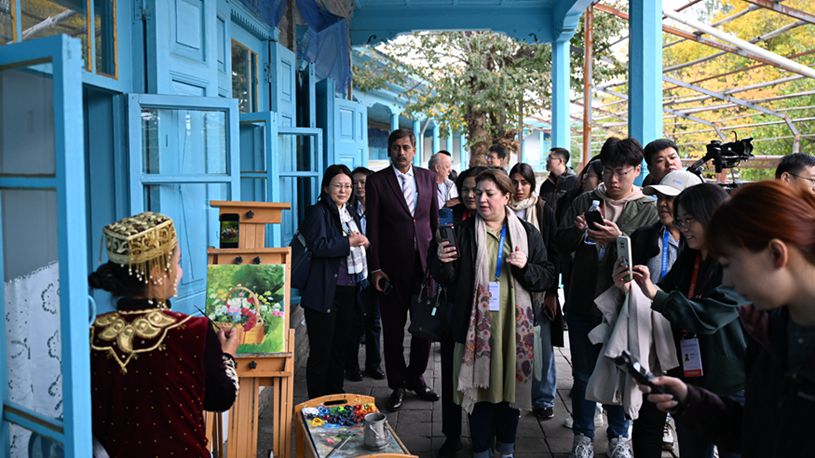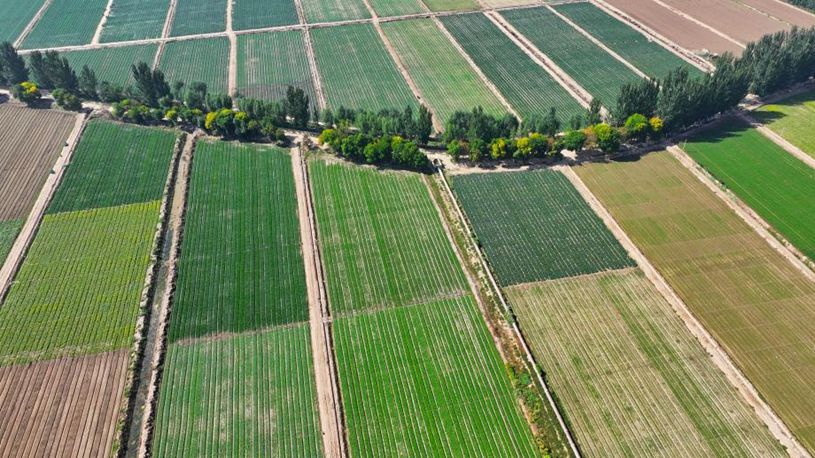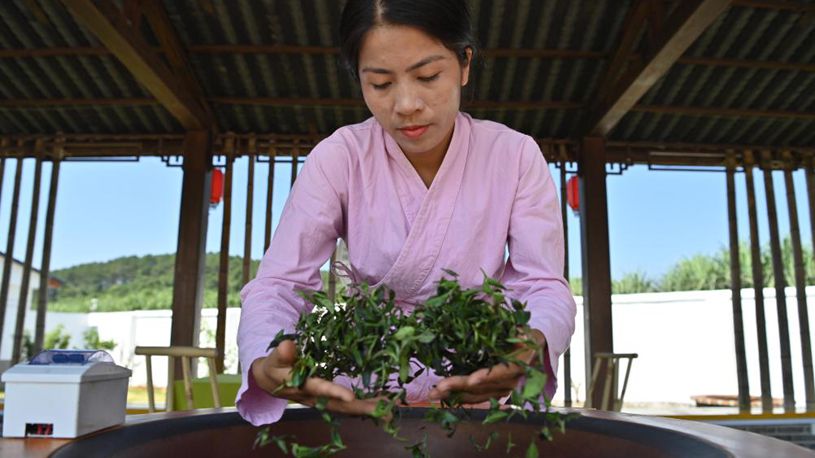by Xinhua writers Ye Ting, Xia Xiao, and Zhang Yu
URUMQI, Oct. 16 (Xinhua) -- Captivated by the beautiful melodies of traditional instruments and the vibrant Uygur dance performance, Joshua Isaac Jere from Zambia couldn't resist the infectious rhythm and warm hospitality, and joined the dancers in their joyous celebration in Jiayi Village.
Jiayi, located in Xinhe County, northwest China's Xinjiang Uygur Autonomous Region, is renowned for its musical instrument production. Jere, an online news media manager of Zambia National Broadcasting Corporation, was part of an overseas media group visiting this small village. The trip followed the opening of the sixth World Media Summit in the regional capital of Urumqi.
"It reminded me of home and I enjoyed it very much," Jere said, noting that the musical instruments share many similarities with those back in his own country.
Jiayi Village has over 300 years of history in Uygur ethnic musical instrument craftsmanship, which has been listed as a national intangible cultural heritage and features more than 10 types of meticulously handcrafted instruments, including Tambur and Dutar.
"I have witnessed the villagers' passion for preserving their traditional culture, especially in the crafts of handmade instruments, which have been passed down through generations," said Kuik Cheng Kang, editor-in-chief of Malaysia's Sin Chew Daily.
Xinjiang's distinct customs and lifestyle offer international visitors a glimpse into the rich diversity and inclusiveness of Chinese culture, a surprising and captivating experience for many, according to Kuik, who also believed that Xinjiang is showcasing its unique charm to the world with more confidence.
This confidence stems from Xinjiang's remarkable cultural and tourism resources, combined with the region's unswerving efforts to forge itself into a more attractive, inclusive and accessible tourism hub.
Covering one-sixth of China's total land area, Xinjiang's unique "three mountain ranges sandwiching two basins" terrain offers breathtaking natural scenery, from towering mountains and deep gorges to vast deserts and serene lakes.
Xinjiang's strategic location along the ancient Silk Road, combined with its diverse array of ethnic minorities, has forged rich cultural heritages. This is illustrated by the region's multiple UNESCO world heritage sites, world intangible cultural heritages as well as national intangible cultural heritages.
The unparalleled blend of natural beauty and historical significance makes Xinjiang a must-visit destination for those seeking both cultural and natural wonders, such as the Tianshan Mountains, Sayram Lake, Jiaohe Ruins and Kashgar Old Town.
Beneath the soft glow of moonlight, another group of overseas travelers wandered into the 2,000-year-old ruins of Jiaohe. Once a key stop on the ancient Silk Road in Turpan, it now stands as the world's largest and best-preserved clay-built ancient city. Accompanied by the sounds of flutes and strings, the visitors felt like they had been transported through time, immersing themselves in the ancient world through the performers' chants.
"The Jiaohe Ruins exemplify advanced concepts in cultural relic protection and cultural tourism development in China. They not only preserve the original appearance of the site but also enhance the experience with thoughtfully designed pathways, lighting, cave landscaping, background music and performances, creating a tranquil atmosphere that harmonizes with the ancient city," said Marcelo Benez, chief commercial officer of Folha de S.Paulo.
He said the trip to Turpan provided him with an unprecedented experience. "This remarkable place is incredibly diverse, where the past and future, history and modernity, technology and tradition intertwine in an almost unbelievable way. For first-time visitors, surprises seem to arise at every turn."
Delvin O'Neale Thoma, deputy minister of Media Department of Republic of Nauru, said he had only seen such cultural relics in documentaries before and being able to stand amidst such a historically significant site left a deep impression on him.
In recent years, tourism in Xinjiang has surged in popularity, driven by a range of measures designed to enrich the travel experience, improve transportation options, and ensure the sustainable preservation of cultural resources.
Between January and September 2024, Xinjiang received 245 million tourists from home and abroad. Tourism revenue for the first three quarters of 2024 and that of the entire 2023 reached 287.58 billion yuan (about 40.4 billion U.S. dollars) and 296.72 billion yuan, respectively.
Xinjiang is also enhancing its tourism infrastructure by focusing on developing world-class tourist destinations, resorts, and cities over the next three years. Key scenic roads, such as the Duku Highway, will be upgraded into top self-driving routes.
Improved transportation, including domestic and overseas flight routes and rural road projects, will further boost the region's tourism growth, according to Sun Hongmei, vice chairperson of the regional government.
By promoting internationalized tourism services, including accepting foreign bank cards, streamlining hotel check-in procedures to reduce wait times, and enabling foreign tourists to reserve tickets using passports and permanent residence IDs online, Xinjiang is also committed to enhancing convenience for overseas tourists. ■
















